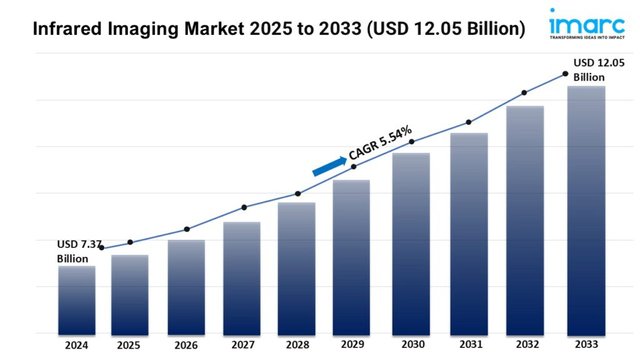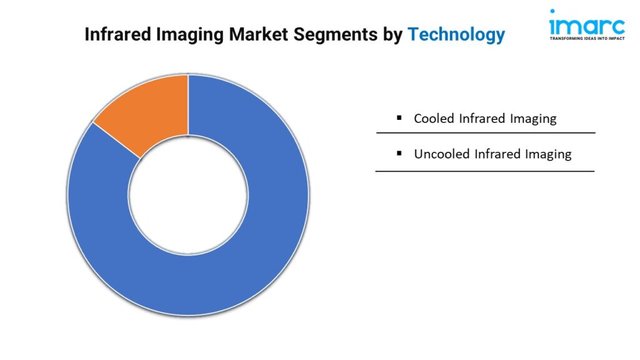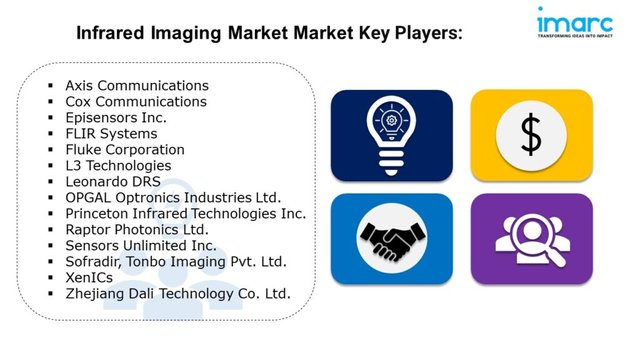Global Infrared Imaging Industry: Key Statistics and Insights in 2025-2033
Summary:
- The global infrared imaging market size reached USD 7.37 Billion in 2024.
- The market is expected to reach USD 12.05 Billion by 2033, exhibiting a growth rate CAGR of 5.54% during 2025-2033.
- North America leads the market, accounting for the largest infrared imaging market share.
- Uncooled infrared imaging holds the market share in the technology segment.
- Based on the component, the market has been divided into IR detectors, IR lens systems, IR sensors, and others.
- Shortwave infrared (SWIR) dominates the infrared imaging industry.
- Security and surveillance represents the biggest market share, driven by the increasing adoption of infrared imaging in defense, border security, and public safety initiatives.
- Non-industrial is the leading industry segment.
- The increasing demand in military and defense applications is a primary driver of the infrared imaging market.
- The rising applications in medical diagnostics and patient monitoring and the growing use in the energy and utilities sector are reshaping the infrared imaging market.

Industry Trends and Drivers:
- Increasing demand in military and defense applications:
Increase market growth of infrared imaging for advanced surveillance and targeting purposes in military as well as defense establishments. Infrared imaging technology detects temperature variations in objects and therefore does not rely on lighting conditions. Whereas a variety of uses, ranging from reconnaissance missions to target acquisition, this forms an imperative part of situational awareness in operations that usually require night vision. All or most nation defense agencies have adopted the infrared imaging technique to enforce border security with reliable strategic monitoring to counter any terrorist threats. The use of infrared imaging is inevitable in areas where visibility is very limited; such an opportunity would be to the military and allow them to see potential threats or movements without revealing their locations. Also, infrared imaging is being incorporated into UAVs and many autonomous ground vehicles, further maximizing the area of its applicability in military operations.
- Applications in medical diagnostics and patient monitoring:
The rising employment of infrared imaging in medical diagnostics, particularly for its non-invasive and radiation-free approach to monitoring physiological changes in the body, is bolstering the market growth. This technology is used for the early detection of diseases providing critical insights into disorders such as vascular diseases, tumors, infections, and neurological conditions. The application of infrared imaging in oncology helps identify the presence of irregular blood flow or abnormal cell growth that may be cancerous. It also serves the purpose of detecting fever and inflammatory conditions, hence tackling the concerns of infection control. Both early diagnosis and preventive care are being given priority among healthcare providers, thereby making infrared imaging a useful tool in clinical situations. Increased focus on minimally invasive (MI) diagnostics and awareness about early disease detection are supporting the transition of infrared imaging toward acceptance in therapeutic applications.
- Growing use in the energy and utilities sector:
Growing application of infrared imaging in the energy and utilities sector for monitoring and maintenance of critical infrastructure is a market growth driver. The infrared imaging technique is applied in power plants, substations, and distribution systems to detect hotspots or thermal anomalies that may indicate equipment failure or energy inefficiencies. Rising energy demand has prompted utility companies to reduce downtime and maximize efficiency, augmenting preventive maintenance needs. Infrared cameras allow operators to identify possible faults before they escalate and take appropriate action, thus avoiding large-scale breakdowns. Meanwhile, this technology plays a major role in renewable energy sectors - for inspection of solar panels and wind turbines.
Request for a sample copy of this report: https://www.imarcgroup.com/infrared-imaging-market/requestsample
Infrared Imaging Market Report Segmentation:
Breakup By Technology:

- Cooled Infrared Imaging
- Uncooled Infrared Imaging
Uncooled infrared imaging exhibits a clear dominance in the market due to its cost-effectiveness, compact design, and versatility across various applications.
Breakup By Component:
- IR Detectors
- IR Lens Systems
- IR Sensors
- Others
Based on the component, the market has been divided into IR detectors, IR lens systems, IR sensors, and others.
Breakup By Wavelength:
- Near Infrared (NIR)
- Shortwave Infrared (SWIR)
- Mid-Wave Infrared (MWIR)
- Long-Wave Infrared (LWIR)
- Others
Shortwave infrared (SWIR) represents the largest segment because it provides high-resolution imaging capabilities in low-light conditions and can penetrate through atmospheric conditions like fog and haze.
Breakup By Application:
- Security and Surveillance
- Monitoring and Inspection
- Condition Monitoring
- Structural Health Monitoring
- Quality Control
- Detection
- Gas Detection
- Fire/Flare Detection
- Body Temperature Measurement
Security and surveillance hold the biggest market share, driven by the growing demand for enhanced safety measures and the increasing adoption of infrared imaging in defense and law enforcement.
Breakup By Vertical:
- Industrial
- Automotive
- Aerospace
- Electronics & Semiconductor
- Oil & Gas
- Military and Defense
- Others
- Non-Industrial
Non-industrial accounts for the majority of the market share owing to the extensive use of infrared imaging in healthcare, automotive, and consumer electronics for various applications.
Breakup By Region:
- North America (United States, Canada)
- Asia Pacific (China, Japan, India, South Korea, Australia, Indonesia, Others)
- Europe (Germany, France, United Kingdom, Italy, Spain, Russia, Others)
- Latin America (Brazil, Mexico, Others)
- Middle East and Africa
North America dominates the market attributed to its strong technological infrastructure, significant defense spending, and high adoption of advanced security and surveillance systems.
Top Infrared Imaging Market Leaders:

The infrared imaging market research report outlines a detailed analysis of the competitive landscape, offering in-depth profiles of major companies. Some of the key players in the market are:
- Axis Communications
- Cox Communications
- Episensors Inc.
- FLIR Systems
- Fluke Corporation
- L3 Technologies
- Leonardo DRS
- OPGAL Optronics Industries Ltd
- Princeton Infrared Technologies Inc.
- Raptor Photonics Ltd.
- Sensors Unlimited Inc.
- Sofradir
- Tonbo Imaging Pvt. Ltd.
- XenICs
- Zhejiang Dali Technology Co. Ltd.
If you require any specific information that is not covered currently within the scope of the report, we will provide the same as a part of the customization.
About Us:
IMARC Group is a global management consulting firm that helps the world’s most ambitious changemakers to create a lasting impact. The company provide a comprehensive suite of market entry and expansion services. IMARC offerings include thorough market assessment, feasibility studies, company incorporation assistance, factory setup support, regulatory approvals and licensing navigation, branding, marketing and sales strategies, competitive landscape and benchmarking analyses, pricing and cost research, and procurement research.
Contact Us:
IMARC Group
134 N 4th St. Brooklyn, NY 11249, USA
Email: [email protected]
Tel No:(D) +91 120 433 0800
United States: +1-631-791-1145